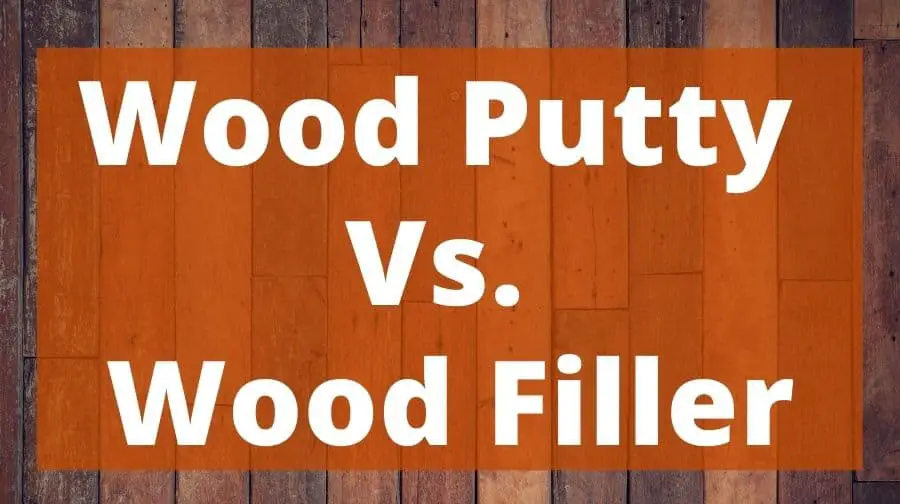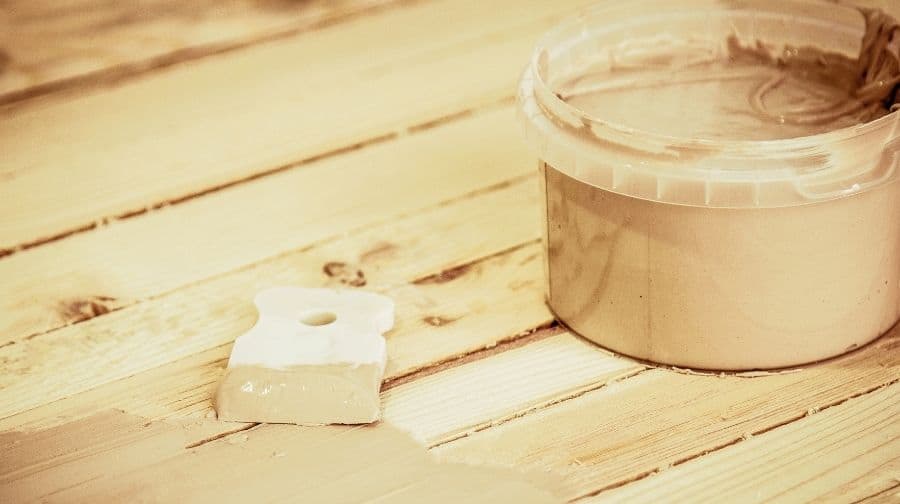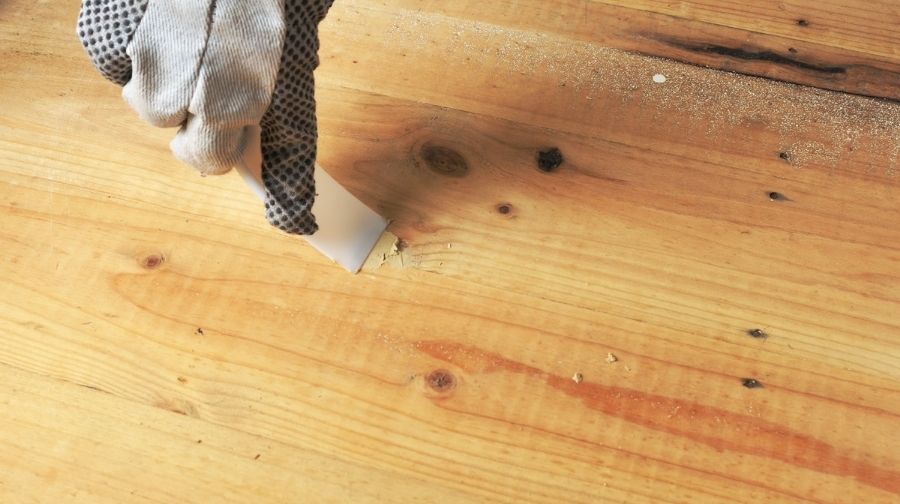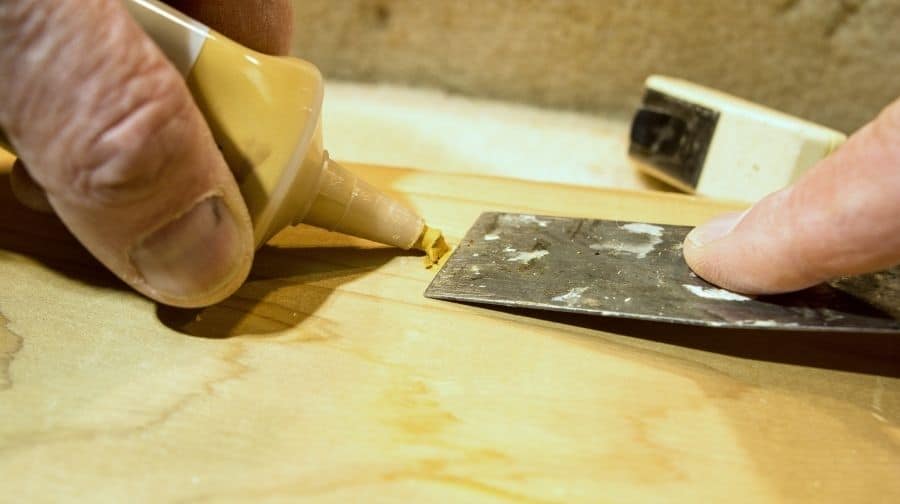
If you are not an experienced woodworker, wood putty & wood filler may appear to be the same.
They both are used to fill holes or repair damage in the field of woodworking. However, while many people use the terms interchangeably, they are genuinely distinct. And being able to differentiate one from another will assist you in avoiding the pitfalls that many others have fallen into before you.
Wood filler is different from wood putty because it is often composed of sawdust which suspended in such a binder. Wood putty is typically composed of a plastic-like epoxy, fiberglass, or polyurethane. Additionally, putty, unlike filler, does not solidify it expands and contracts with the wood. Wood filler is not weatherproof and will deteriorate over time if left outside.
When repairing or constructing furniture and other wooden things, there are several situations where holes must be filled. These holes may be caused by flaws or irregularities in the wood or the location of the nails.
Furthermore, when it comes to filling holes in a workpiece, a wood filer or wood putty is always the best and, in most situations, the only answer.
Woodworkers frequently use the terms “wood putty” and “wood filler” interchangeably to refer to the same substance. While they perform a nearly identical purpose, they are nonetheless distinct materials best suited for wood filling jobs. We utilize putty or wood filler to fill in cracks and imperfections on the surface of wood and gaps between joints. While we use these two materials for similar reasons, they are somewhat dissimilar.
| Category | Wood Putty | Wood Filler |
| Ingredients | Wood putty ingredients typically are sawdust or wood flour, calcium carbonate, binders, pigments and boiled linseed oil. | Wood filler ingredients are polymers, resins, solvents, wood fibers, latex, PVA (Polyvinyl Acetate), water and colorants. |
| Consistency | Wood Putty feels like a dense, rubbery material. | Will filler feels like a creamy paste material. |
| Color | Wood putty comes in many colors to match your project’s stain like walnut, ebony, golden oak, mahogany, white, oak, maple, cherry and natural pine. You can also mix in dyes or pigments to match your project’s color. | Wood filler is paintable and stainable so they typically come in it’s neutral beige color but companies are not making color matched wood filler like walnut, golden oak, white, burlywood, cherry, dalbergia, teak, black walnut and black. |
| Price Range | Wood putty ranges in price from $0.87-$2.33 per ounce of material. Wood putty typically comes in smaller containers and color already added making it more expensive. You can also buy sticks of wood putty and are about $1.04 per inch of stick sold in 7 inch sticks. | Wood filler ranges in price from $0.45-$1.43 per ounce of material depending on the size of the container. |
| Uses | Wood putty is used to repair nail holes and scratches on finished projects that have already been stained like furniture or trim. It is also used to fill in the gaps between two pieces of wood that are being glued together. | Wood filler is used for unfinished projects or before painting and staining. It can be used to fill gaps, holes, etc. on bare wood or after priming and it will accept paint and stain like the rest of the project. |
| Drying Time | Wood putty doesn’t fully dry. Because it is oil based it remains pliable and won’t dry 100%. It isn’t meant to dry and provide structural support. It is meant to color match your project’s stain to hide small holes, chips or cracks. | Wood filler does fully dry. A thin layer will dry within 30-60 min and be ready for stain or paint. If you need to fill a large gap you can either apply in thin layers or provide more drying time if applied in a thick layer. |
| Sandability | Wood putty is not meant to be sanded after application. It should be applied then excess wipes away allowing it to set. | Wood filler can be sanded after it dries. |
| Hard vs Pliable | Wood putty remains pliable after applying which helps it remain in place if your project wood expands and contracts with the change in humidity levels. | Wood filler dries hard after applying making it better for edge and corner repairs but can crack over time and will need repair. |
| Interior vs Exterior | Wood putty is a great product for interior and exterior projects because it remains pliable and won’t crack or shrink if your project wood expands or contracts outdoors. | Wood filler is best for interior projects because it isn’t pliable and will crack if the wood expands and contracts due to humidity changes outdoors. |
| Finished vs Unfinished | Wood putty is meant to be used on finished projects and color matched to your stain color. You can either buy it pre-colored, mix 2 colored wood putties together or mix in dye or pigments to create your own color to match your finished project color. | Wood filler is meant to be used on unfinished projects because it can be painted or stained after drying. It can also be purchased pre-mixed with color to match common stain colors. |
What Is Wood Putty?
Wood putty is a type of dense rubbery material wood filler made from a mixture of sawdust or wood flour, calcium carbonate, binders, pigments and boiled linseed oil. It can be purchased in a variety of colors to match the color of your wood project such as walnut, ebony, golden oak, mahogany, white, oak, maple, cherry and natural pine.
When To Use Wood Putty
Wood putty should be used to fill in small holes and cracks, as well as to level out any unevenness on the surface of the wood on finished or stained projects.
You should use it on projects such as furniture, cabinets, and trim work.
What Is Wood Filler?
Wood filler is a material used to fill holes, cracks, or voids made from polymers, resins, solvents, wood fibers, latex, PVA (Polyvinyl Acetate), water and colorants and can be applied with a putty knife or other similar tool.
It is a neutral beige color because it’s paintable and stainable but also is available in different colors such as walnut, golden oak, white, burlywood, cherry, dalbergia, teak, black walnut and black.
When to Use Wood Filler
Wood filler should be used to fill nail holes, cracks, or small defects in wood for interior projects. It is not meant to be used as a general purpose adhesive. If you need to glue two pieces of wood together, use wood glue instead.
You can use wood fillers on projects such as furniture, cabinets, and trim work.

What’s The Difference Between Wood Putty And Wood Filler?
The primary differences between Wood Filler and Wood Putty are:
- Wood filler is often a water-based product, while the wood putty is typically oil-based.
- While wood filler is sandable and generally used on unfinished wood, wood putty cannot be sanded and is excellent for finished wood.
- Wood fillers should be reserved for indoor woodworking tasks, but wood putty may be utilized in any climate.
Indeed, there are plenty. However, one significant difference between wood putty & wood filler is their ingredients. Wood putty is composed of plastic chemicals and molecules derived from oil. Wood filler is composed of wood particles and fibers that have been combined with a binder.
To restore the wood from the inside, wood filler is used. As it hardens, it aids in the preservation of the wood’s integrity. At the same time, wood putty is often applied only when the finishing process is complete due to chemicals that may cause the wood to deteriorate.
Additionally, most manufacturers provide wood putty in a variety of hues to complement various wood stains. As a result, it generally merges in with the wood. This cannot be said of wood filters, which are often only available in a single hue.
Wood Putty: Pros and Cons
Pros
- More affordable. A tiny quantity of wood putty has a long shelf life, making it a more economical filling ingredient. Even if it becomes dry in the bottle, just a few drops of acetone will suffice to rehydrate it.
- Adhesive characteristics. Because wood putty possesses adhesive qualities, it is not always necessary to employ a seal. This will, however, only work on oil-based finishes.
- Ideally suited for outdoor furnishings. Compared to wood filler, putty resists shrinking and is more resistant to the sun and rain, making it the finest choice for outdoor furniture. Most woodworkers choose to use putty over fillers because it is more adaptable to a range of finishes.
Cons
- Increased drying time. Many wood putties take longer to dry than wood fillers and won’t fully harden. The primary drawback is that a light-colored wood putty can gather dust and darken with time.
Wood fillers: Pros and Cons
Pros
- Relatively quick to dry. Wood filler begins drying around ten minutes after application and should cure entirely in most cases within 24 hours.
- Available in a variety of types. There are more sorts of wood fillers than there are varieties of wood putty. From stainable wood fillers to latex, epoxy, and polyurethane varieties, you can be sure to find one that meets your specific demands.
- More versatile. Due to the variety of types of wood filler available, it is more adaptable than wood putty. And there are many applications for it when creating indoor furnishings.
Cons
- There are no adhesive characteristics. Unlike wood putty, fillers lack adhesive qualities, meaning you must still seal the workpiece after applying the filler.
- This item is not expandable. When wood expands and compresses, wood fillers do not expand and instead shatter. As a result, it is not recommended for outdoor furniture or other goods exposed to the weather.
How to Choose and Use Wood Filler | This Old House
Subscribe to This Old House on YouTube
The best substances for plugging holes and filling cracks, with This Old House general contractor Tom Silva.
Putty wood filler is an extremely common product in most woodworking shops, but which is the BEST wood filler? In this video, I’ll go over 7 of the most common wood fillers and which I think I personally think is the magic-silver-bullet-unicorn putty wood filler we’re all looking for.
Can You Paint Over Wood Putty?
No, you can’t paint over wood putty but it does come in pre-mixed colors that match various wood stain colors. You can also mix 2 colors together or mix dye or pigments to create the color needed.
If you want to paint over your filler than you should use a stainable wood filler.
Putty Wood Filler HEAD-TO-HEAD | Which Is The Best Wood Filler?
Subscribe to Craftswright on YouTube
Is Wood Filler Stronger Than Wood?
Wood filler is not stronger than wood. In fact, it is quite the opposite. Wood filler is made from sawdust and other materials that are bound together with a binder. This makes it much weaker than solid wood.
Should I Use Wood Filler Or Wood Putty?
Wood putty should be used on finished or stained projects for indoor or outdoor projects because it resists shrinking and is also more resistant to the impacts of natural factors such as sun and rain.
Wood filler should be used on unfinished interior projects that haven’t been stained or painted yet.

Does Wood Filler Work Outdoors?
Wood filler does not work outdoors. It is not ideal for outdoor projects because with the weather outside the wood will expand and contract through the year and the hardened wood filler will crack.
If you’re going to use it outdoors, wood putty is your best choice because it’s oil-based, whereas wood filler remains water-based.
Wood filler, in general, solidifies to a sandable consistency. While this method works well for indoor crafts, outdoor projects frequently detach from the wood filler due to the wood’s seasonal expansion and contraction.
What Is The Best Exterior Wood Filler?
The best exterior wood filler is one that is durable, easy to use, and versatile. It should be able to withstand the elements and fill in any gaps or cracks in your woodwork. Bondo or epoxy resin are two popular choices for exterior wood filler.
Bondo is a two-part epoxy that is mixed together and then applied to the surface. It dries quickly and can be sanded down to create a smooth finish. Bondo is ideal for repairing small cracks or holes in woodwork.
Epoxy resin is a stronger, more durable option for exterior wood filler. It is applied in a similar way to Bondo, but takes longer to dry. Epoxy resin is more suited for repairing larger cracks or damage to woodwork.
Wood Filler. Putty for Wood Restoration. DIY Wood Repair
Subscribe to The Restorer on YouTube
What Can I Use Instead Of Wood Filler?
Here are some options to use instead of wood filler:
- Latex filler is a popular kind that is water-based for simple cleanup. Additionally, latex fillers blend well with dyes, making them an excellent alternative for filling big holes and cracks in unpainted wood.
- Wood putty is a type of modeling clay that is used to fill in small holes and cracks in wood surfaces. It is available in a variety of colors, so you can match it to the color of your woodwork.
- A wood patch is a piece of wood that is cut to fit over the hole or crack. You can find patches at most hardware stores.
- Caulk is a type of sealant that can be used to fill in small gaps and cracks. It is available in a variety of colors, so you can match it to the color of your woodwork.
- A filler rod is a piece of metal that is inserted into the hole or crack and then welded in place. This option is best for larger holes or cracks.
- A wood plug is a small piece of wood that is inserted into the hole or crack. This option is best for larger holes or cracks.
- Epoxy filler is a two-part epoxy that comes in a tube. It is mixed together and then applied to the crack or hole. It dries clear, so it can be used on any color of woodwork.
Is Bondo A Good Wood Filler?
Yes, it could be used to rebuild or restore decking, fence, siding, and other external outdoor wood surfaces rotted or damaged. We suggest Bondo Wood Filler for outdoor work. The two-part recipe dries to a medium brown color reminiscent of wood and then repairs and rebuilds decaying and otherwise damaged wood. You may also use it to complete missing puzzle parts.
After 25 minutes, you may plane, drill, route, or saw this non-shrinking filler as required. Not just that, but cured Bondo may be stained or painted just like genuine wood. Although it was designed for vehicle body repairs, it performs very well as a wood filler. This product adds structure and allows for the reconstruction of chunked corners and big gouges. It comes in a quart container and requires mixing with a cream hardener before application.
Can I Use Wood Filler On Rotted Wood?
No, you cannot use wood filler on rotted wood. Rotted wood needs to be removed and replaced with new wood before any type of filler can be used.
Wood filler is not made to adhere to rotted wood, nor will it provide the strength or support that rotted wood needs. If you try to use wood filler on rotted wood, it will simply fall out or crumble away.
Wood Filler – Buy it or Make it? / DIY Wood Filler
Subscribe to Walkers Woodworks on YouTube
In this video I show you guys how you can make your own wood filler that will match your project perfectly! Also I compare it to bought canned wood filler.
What If It Rains On Wood Filler?
Wood Filler is not weatherproof and will deteriorate over time if left outside. Wood filler is distinguished from wood putty because it is often composed of sawdust or wood fibers suspended in such a binder. Putty typically consists of a plastic like fiberglass, epoxy, or polyurethane. Additionally, putty, unlike filler, does not solidify.
Can You Use Wood Filler For Large Gaps?
No, you can fill cracks with wood fillers but not large gaps. Caulk, sealants, and expanding foam should be used to fill gaps. Attempting to use wood filler will not work. Not to mention that it would take an eternity to perfect and would be prohibitively expensive.
Thus, we’ve defined wood filler & wood putty and explained when and when not to use each. Now you must decide which option makes the most sense for your woodworking. Both wood putty & wood filler are materials that perform as intended, sealing the wood surfaces of your project. Each also serves an excellent job of concealing and fixing wood flaws.
However, bear in mind that you may have to use filler or wood putty, depending on the sort of wood you’re dealing with. Additionally, it’s critical to keep in mind that you’ll like to use wood putty if you’re working on an outside job.
Whatever sort of project you’re working on, it’s great to know that alternatives are available to assist in concealing flaws and defects, resulting in an excellent completed product.

